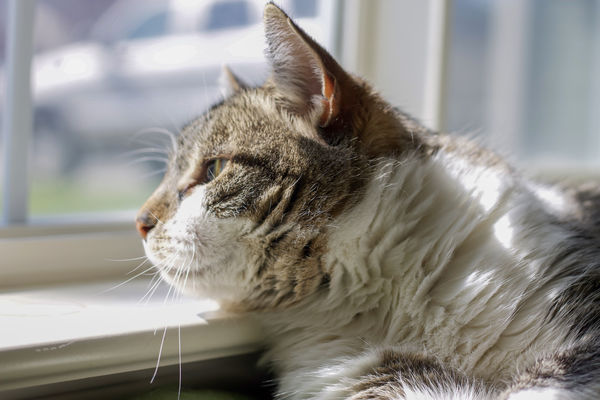Exposure?????
Apr 12, 2020 09:34:51 #
Histograms are a guide at best. One needs to understand what the histogram is before one places their entire faith in it.
--Bob
--Bob
Bob Mevis wrote:
Try your histogram, and practice a or. It will come to you.
Apr 12, 2020 09:39:18 #
What helped me in the beginning was to turn on "highlight" and "shadow" clipping warnings in your software and move the "Blacks" and "highlight" sliders till the clipping shows, then move your shadow slider to your liking. This will help you to get started give you a good boundary to work within.
Apr 12, 2020 09:40:29 #
Rod Clabaugh wrote:
Being somewhat new to photography I have a question. When it comes to taking photos how can you tell if a picture is under or overexposed? Isn’t a little subjective? I find the task of photo editing daunting because I’m not sure if I should change a picture or not. It really handcuffs me sometimes because I don’t want to ruin a photo.
Thanks for asking this question! I’m struggling with editing too, and you have received a number of excellent (and polite!) responses! I’m going to save this thread to refer back to.
What software do you use? I used what came on my PC—Photo by Microsoft—but now that I am trying Luminar 3, I can see it is much better! ( If I had waited a year, I think Luminar 4 is even better.) I was not ready to invest in Lightroom, but I may have to. On One is also highly recommended.
Good job on the soft background in your photo, by the way!
Apr 12, 2020 09:40:29 #
rmalarz wrote:
Histograms are a guide at best. One needs to understand what the histogram is before one places their entire faith in it.
--Bob
--Bob
I think just look at the picture on a well calibrated monitor and decide. It's up to the photographer to decide.
Apr 12, 2020 09:46:11 #
dbfalconer wrote:
Thanks for asking this question! I’m struggling w... (show quote)
You might consider Affinity Photo. One time charge (Current specials are under $30) with frequent free updates. Not as complete a Raw raster converter as others but very comprehensive after raw is developed.
Apr 12, 2020 09:50:06 #
Also keep in mind that the eye is naturally drawn to the bright areas and dark areas recede. This is what happens to the OP’s image to me. The overexposed area outside the window becomes a bit distracting. I’m sure this could be dealt with in post but it depends on what the photographer desires.
If I am shooting trains and on the shady side of them I will expose for the train and let any sky possibly blow out. I choose this because I care more about the train as the main subject, not the sky.
If I am shooting trains and on the shady side of them I will expose for the train and let any sky possibly blow out. I choose this because I care more about the train as the main subject, not the sky.
Apr 12, 2020 10:06:50 #
Picture Taker
Loc: Michigan Thumb
If you set the camera so it will display a histogram after the shot you can see the graph climbing the wall you have too light if its climbing the right side and too dark if its going up the left side.
You can show the picture and the graph at the same time.
Have fun
You can show the picture and the graph at the same time.
Have fun
Apr 12, 2020 10:24:17 #
A photographer should expose to capture what the eye sees. I don't believe your eyes would have seen the white, blown-out areas as they are in your exposure and I don't believe that was your intent. The details of the white fur are missing or blown out in parts of the cat therefore these parts are overexposed. There are ways to deal with this issue. I suggest you research and find the way you like best in order to bring your shots into proper exposure. You being a beginner I would seriously advise you to learn proper exposure as your standard rather than, as others have suggested, just seeing it as subjective. There is proper exposure in photography and once you become proficient in proper exposure then you can explore the artistic side of exposure. Just being satisfied with the suggestion that if it looks good to me is all that counts is hogwash unless you are an accomplished photographer and can expertly modify light and/or camera settings to obtain the look you desire. Here is a link I hope is helpful to you and I wish you the best: https://photographyhero.com/secret-mastering-exposure-photography/
Apr 12, 2020 10:42:18 #
Rod Clabaugh wrote:
Being somewhat new to photography I have a question. When it comes to taking photos how can you tell if a picture is under or overexposed? Isn’t a little subjective? I find the task of photo editing daunting because I’m not sure if I should change a picture or not. It really handcuffs me sometimes because I don’t want to ruin a photo.
It has to please you first & foremost. I often will Bracket the shot and compare them afterwards to see where it takes me and decide from there. I don't use the Histograms much and probably should learn to so. Because I often shoot different cameras and brands, I lose track of what to expect from a given device and lens combination. This can get you into situations that leave you with Happy Accidents or Shuda-Cuda-Wuda Results. Even a Squirrel gets lucky now & then.
I'm never really sure about what I got until I view it on a bigger screen at home ,usually a day or so later and that's when the Bracketed-Sets pay off . I don't do much PP and so try to compose the shots as well as possible and don't rely on software to save me from myself but if I only knew more about HDR and stacking , my works could come to life a whole lot better I suspect.
Good Luck and keep testing yourself . The more you practice, the better you'll become and you'll discover your margins and limitations.

Apr 12, 2020 11:42:19 #
By reducing the highlights the overall exposure has been brought under control so that details appear in shadows and highlights.


Apr 12, 2020 11:49:26 #
Photograph is too light. Highlights need to be brought down learn how to use Photoshop now that you’re quarantined you’ll have plenty of time to practice. There are hundreds of books and thousands of tutorials. Photoshop CS6 or subscribe to cc for $9.98 a month best money you ever spent
Apr 12, 2020 11:58:46 #
Rod Clabaugh wrote:
Being somewhat new to photography I have a question. When it comes to taking photos how can you tell if a picture is under or overexposed? Isn’t a little subjective? I find the task of photo editing daunting because I’m not sure if I should change a picture or not. It really handcuffs me sometimes because I don’t want to ruin a photo.
Every image has darks, lights and mid-tones. At one end of the range are the shadows or blacks and at the other end of the spectrum are the highlights or lights, on a histogram the darks would be on the left end and the lights would be on the right end. In between these two extremes are the mid-tones. When you take a shot the majority of the tones (the depth of colors in a color shot) are in the mid-tone area, this creates that "hump" in the histogram. Then the hump tapers off to the darks and lights, and the line of the histogram for darks and lights is generally much lower. You can take a shot, however, with the intention of creating a very dark or a very light shot, this shot would be called low-key or high-key and the histogram would reflect that. Learning tones and how this affects colors is part of being a successful photographer. When you take a shot you can expose for what you want it to be, from low-key to mostly mid-tones to high-key. It all depends on what you want to do at that moment and on the subject you are photographing and the mood you want to create.
An addition to this in regards to taking a shot: The best thing to do, when framing a shot, is to notice what is happening around the subject and understand what that might mean. In this case, all of the white around the cat. When you see this much white around a subject you have to plan to compensate for it. One way to do this is to set your exposure point on the white and thus "expose for the highlights" and take the shot, knowing that you will need to "bring up the shadows" in post. Another way to handle this is to find a better background for your subject, although in this shot I understand the cat was doing his/her own thing (I also take shots of my cat). Another option, in this type of case, is to hone in on the subject and avoid as much white as possible. Taking good images is about knowledge and skill and both of those can come over time.
Apr 12, 2020 12:01:57 #
At some point a photosite can't absorb any more photons, so that kind of blown highlight cannot be recovered in post no matter which software is used. So you have to keep the exposure in camera below the point that there is no detail at all remaining. Colors also get strange with overexposure because one primary color might blow sooner than another and even if the other two can be corrected the software has to guess what to do with the blown one.
Apr 12, 2020 12:09:16 #
Rod Clabaugh wrote:
Being somewhat new to photography I have a question. When it comes to taking photos how can you tell if a picture is under or overexposed? Isn’t a little subjective? I find the task of photo editing daunting because I’m not sure if I should change a picture or not. It really handcuffs me sometimes because I don’t want to ruin a photo.
As others have said, what matters is whether you like the effect. To my eye the picture is overexposed because the detail in the cat’s fur is washed out. I have not read all the comments so this suggestion may be repetitive, but it looks like you were focused on the cat’s darker fur, which overexposed the white. Next time you try this shot or something similar, focus and meter on the white fur. Your darks will be darker but the white will be clearer. I don’t do sophisticated editing, but I find it easier to correct for underexposed darks than overexposed lights when they are in the same picture.
Apr 12, 2020 12:16:39 #
JFCoupe
Loc: Kent, Washington
Kozan wrote:
Rod, I think it is slightly over-exposed. But jus... (show quote)
I think you have provided the OP with some very good input to think about as he evaluates his images.
If you want to reply, then register here. Registration is free and your account is created instantly, so you can post right away.








